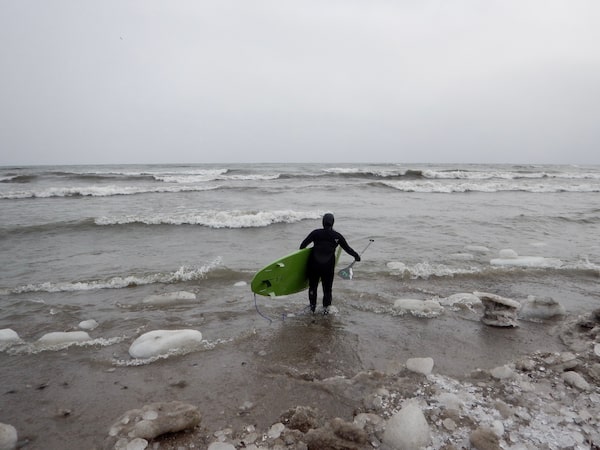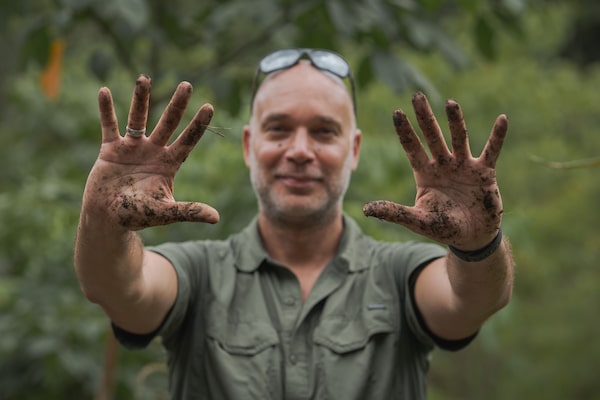If you’re reading this on the web or someone forwarded this e-mail newsletter to you, you can sign up for Globe Climate and all Globe newsletters here.
Good afternoon, and welcome to Globe Climate, a newsletter about climate change, environment and resources in Canada.
Spring has finally arrived, but for some surfers across Canada, winters’ chilly air — and even chillier water — is no obstacle to hitting the waves and hanging ten. In Tofino, on B.C.’s Vancouver Island, on the shores of Ontario’s Great Lakes, and off the coast of Halifax, dedicated surfers suit up no matter the conditions.
For these surfers, who include members of Tofino’s Surf Sister, one of the oldest surf schools in the world run by women, a consistent winter chill is integral to enjoying Canada’s oceans and lakes year-round. Or, as Nico Manos, Nova Scotia’s first and only professional surfer, says: “It makes you feel alive.”
Now, let’s catch you up on other news.

Robin Pacquing at Marie Curtis Park in Etobicoke, Ont.
Noteworthy reporting this week:
- Canada’s climate plan: Later this week, the federal government will deliver its plan for meeting the country’s climate targets, which will include the expectation that the oil and gas industry reduce its emissions by 30 to 40 per cent. While possible, meeting this optimistic goal will likely require significant government support and funding.
- Sustainable travel: In New Zealand, post-pandemic travel combines sustainability with style.
- Forests: Scientists from around the world are urging Canada’s federal government to prioritize the protection of Canada’s most biodiverse forests, and to review how forestry emissions are quantified.
- Green investing: Part of Jo Taylor’s bold plan for the Ontario Teacher’s Pension Plan: moving away from oil and gas — largely, he says, because plan members aren’t keen on fossil fuel assets.
- From The Narwhal: As the endangered piping plover returns to nest on Sauble Beach, the town is embroiled in a court case over whether regular beach maintenance, to support Sauble’s huge tourist industry, jeopardizes the birds’ natural habitat.
A deeper dive
How to move a city
Ryan MacDonald is a senior editor at The Globe heading the climate, environment and resources team. For this week’s deeper dive, he spoke with reporter Joshua Irwandi, who reported on Indonesia’s decision to physically relocate Jakarta, its capital city.
Joshua Irwandi’s stunning visual journey into Indonesia’s decision to move its capital from Jakarta to Nusantara on the island of Borneo was more than a year in the making.
When Joshua first talked to the Globe about the story, Indonesia was in the grips of a deadly wave of the COVID-19 pandemic. A year later, many Indonesians are questioning whether creating a “forest city” should be a priority for a government that is still hurting from the economic fallout from the pandemic.
Indonesia is not the first country to make this decision. Brazil, Myanmar and most recently Egypt have all done the same thing. In most cases, these moves have been questioned as creating political capitals that benefit elites while leaving the poor behind.
But unlike other countries, Indonesia’s decision may be the first “managed retreat” from the effects of climate change. Jakarta is sinking and the Java Sea is rising. That’s certainly not the only problem Jakarta is facing, but it’s the most pressing. One third of the city could be submerged by 2050. And it’s personal for Joshua.
“Yes, the issue of Jakarta sinking is one in which I myself have been affected,” he told me. “On New Year’s Day 2020 our housing compound was flooded. We lost two of our cars.”
To tell the story, Joshua contrasts the conditions in Jakarta with the promise of Nusantara. That promises means different things for different people. For the political class, it means living in a smart city with ample green space and public transit; for Indigenous communities, the rise of the new city means they will be displaced. Developments and construction are taking place as we speak.
For Sibarani Sofian, the project’s lead designer, the new city is an opportunity to showcase how the world can confront climate change through design.
“We hope the capital city will become a role model for other cities in Indonesia. The dream is that.”

Houses are partially submerged in the housing compound of Puri Indah, during the flood that affects the majority of West Jakarta on New Year's Day.Joshua Irwandi/The Globe and Mail
What else you missed
- Climate policy was a factor in last week’s NDP/Liberal deal.
- Stellantis NV STLA-N and South Korean battery maker LG Energy Solution will partner on a $5.1-billion electric-vehicle battery plant in Windsor, Ont., the first large-scale plant of its kind in Canada.
- Canada’s producers can boost exports of oil and natural gas to the United States this year, as part of an international effort to help the world move away from Russian energy.
- A new study has found that the highest earning 60 per cent of households in Ontario, Manitoba, Saskatchewan and Alberta are worse off under carbon pricing, while the bottom 40 per cent are somewhat better off.
Opinion and analysis
The Globe Editorial Board: Cutting taxes at the gas pump is the wrong idea
Kamal Al-Solaylee: Yemen is starving, but the deepest hunger is for peace
Keith Porter: Canada needs to design buildings that will shrink its disaster credit card balance
Green Investing
Canada to issue first green bonds this week
Canada’s Department of Finance said Monday that it intends to sell $5-billion worth of green bonds to investors this week, “subject to market conditions.” The proceeds will be earmarked for environmentally focused projects, which could range from infrastructure spending to pollution reduction and forest preservation.
The global market for green bonds has grown rapidly in recent years, as investors have begun prioritizing assets that align with environmental, social and governance (ESG) goals, while governments have looked for ways to fund green infrastructure projects at a lower cost. And, though Canada has lagged in terms of federal government green bond issuance, the broader market for sustainable debt has expanded quickly. Read Mark Rendell’s full analysis here.
Also:
- The rise in popularity of green bonds has led to concern over “greenwash” bonds that don’t live up to their environmental promises
- Prior to the Russian invasion of Ukraine, Russian ESG stocks were favoured over Canadian ones
Making waves
Each week The Globe will profile a Canadian making a difference. This week we’re highlighting the work of Matt Hill, founder of One Tree Planted.

Matt HillBen Hemmings/Supplied
I’m Matt Hill and I founded One Tree Planted in 2014 to make it simple for people and businesses to help the environment by planting trees.
To date, we’ve planted over 43 million trees through our global conservation efforts. Beyond tree planting, it’s critical that we have the infrastructure to plan, implement and monitor the health of our projects long-term so we can scale and create tangible impact.
Technology plays a vital role in achieving ambitious restoration targets. That’s why we work with strategic partners like Salesforce to help power and track projects of global significance, like our reforestation initiative in BC’s wildfire-ravaged Fraser Plateau.
As a father, I want to make a difference that will benefit the next generation. Planting trees is just one part of that equation. We must also focus on how we measure the impact we’re having in our communities, and in helping Canada meet its ambitious sustainability goals.
- Matt
Do you know an engaged individual? Someone who represents the real engines pursuing change in the country? Email us at GlobeClimate@globeandmail.com to tell us about them.
Photo of the week

In this picture taken on March 25, 2022, a newly-hatched Olive Ridley turtle is released on a beach near a hatchery in Chennai after their eggs were collected by the volunteers and forest department workers lying along the coastline of Bay of Bengal.ARUN SANKAR/AFP/Getty Images
Guides and Explainers
- Want to learn to invest sustainably? We have a class for that: Green investing 101 newsletter course for the climate-conscious investor. Not sure you need help? Take our quiz to challenge your knowledge.
- We’ve rounded up our reporters’ content to help you learn about what a carbon tax is, what happened at COP26, and just generally how Canada will change because of climate change.
- We have ways to make your traveling more sustainable and If you like to read, here are books to help the environmentalist in you grow, as well as a downloadable e-book of Micro skills - Little Steps to Big Change.
Catch up on Globe Climate
- How the B.C. flood changed lives forever along Highway 8
- Russian oil ban puts spotlight on Canada, and our climate ambitions
- In Russia’s war against Ukraine, energy is a weapon
- IPCC report delves into our lack of preparedness, can we still be resilient?
We want to hear from you. Email us: GlobeClimate@globeandmail.com. Do you know someone who needs this newsletter? Send them to our Newsletters page.